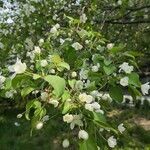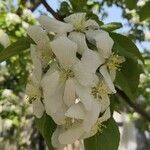Trees, 100–140 dm. Stems to 30 cm diam.; bark dark gray with platelike scales; young branches reddish orange and glabrous, becoming reddish brown; flowering shoots becoming spurs, 3–10(–25) mm. Buds reddish brown, ovoid, 3–4 mm, scale margins tomentose. Leaves convolute in bud; isomorphic; stipules deciduous or persistent on vigorous shoot leaves, lanceolate, sometimes filiform, 3 mm, apex acuminate; petiole 20–50 mm, glabrous; blade elliptic or ovate, 3–8 × 2–3.5 cm, base cuneate or rounded, margins unlobed, serrate, apex long-acuminate, sometimes caudate, surfaces glabrous or slightly puberulent when young. Panicles umbel-like; peduncles absent; bracteoles absent. Pedicels 15–40 mm, glabrous. Flowers ?not fragrant?, 30–35 mm diam.; hypanthium ?constricted distal to ovaries?, glabrous; sepals lanceolate, 5–7 mm, longer than tube, apex acuminate, abaxial surface glabrous, adaxial tomentose; petals white, obovate, 20–30 mm, claws 1–2 mm, margins entire, apex obtuse rounded; stamens 15–20, 7–9 mm, anthers yellow before dehiscence; styles (4 or)5, basally connate to 1/2 length, 8–10 mm, longer than stamens, densely villous basally. Pomes yellow to red, subglobose, 8–10 mm diam., cores enclosed at apex; sepals deciduous; sclereids sparse surrounding core. Seeds light reddish brown. 2n = 34.
A deciduous shrub or small tree. It grows 9 m high. Its is a broad spreading shape. The bark is grey brown and flakes into square plates. The bark is red-brown when it is freshly exposed. The leaves are oval and 7.5 cm long by 4 cm wide. They taper to a pointed tip. There are fine teeth around the edge. Leaves are dark green above and paler underneath. They are smooth on both sides. The flowers are white and in clusters on long stalks. Individual flowers are 4 cm across. The fruit are about 1 cm across. They are round and yellow or red. They are on long stalks.











